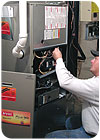
The hybrid movement has now arrived in the HVAC industry, thanks to manufacturers that are responding to consumer demands for lower operating costs. Last year's sky-high gas bills are still on the minds of many homeowners, even though the latest reports indicate that gas won't be as expensive this winter.
Even with lower gas prices in the near future, many consumers are looking to purchase heating equipment that will reduce their energy costs and improve their comfort. Manufacturers and contractors believe the new hybrid heating systems are often the best way to satisfy both of these demands.

HYBRID COMPONENTS
A hybrid heating system follows the same concept as a hybrid car. The combination of gas (furnace) and electricity (heat pump) provide fuel savings. A smart controller automatically selects the most economical source for a homeowner's heating needs. Manufacturers state that this type of system gives homeowners the flexibility to maintain their comfort as weather conditions and energy prices change.Bryant is one of the manufacturers that have ventured into the hybrid market, introducing its Hybrid Heat system earlier this year. The company felt that the continual rising and falling of energy prices precipitated the need for a hybrid system. "With the Hybrid Heat system, when gas is higher than electric, the homeowner has an option to only operate the heat pump, thus saving energy," said Tom Archer, product manager for high-efficiency furnaces, Bryant, Indianapolis.
The amount of energy a homeowner can save with such a system is impressive. Archer noted that on the higher-SEER and -AFUE systems, the payback periods are often just a few years. "We have a software program available that allows dealers to put in a homeowner's existing system, which is typically a 78 percent AFUE furnace with an 8 or 10 SEER air conditioner, and it will determine what the annual cost savings is for a given zip code with given energy cost input. Sometimes the annual savings are in the $1,000 range."
Bryant dealers can also use the program to outline payback periods for good, better, and best hybrid systems. There are many different configurations available; the "best" system consists of a variable-speed, two-stage, 18 SEER heat pump combined with a two-stage, 96.6 percent AFUE gas furnace.
This is the type of system that Karl Skog, owner, Crosslake Sheet Metal, Crosslake, Minn., typically sells to his customers. "With the tools we have to offer, the Hybrid Heat system pretty much sells itself," he said. "When homeowners can see what the payback period is on the equipment versus just putting in the standard straight gas heat-air conditioning, they want that system."
TALKING UP THE BENEFITS
The area that Skog services is primarily a resort area, in which affluent consumers build their sprawling vacation homes. Most of Skog's work is new construction, and when builders give him the opportunity to meet with customers, they invariably ask to have the best Hybrid Heat system installed.In the last three months, Skog estimated that he's installed approximately 40 of the high-end systems, and since he installed one in his own home, he knows of what he speaks. "The setup at my house may not be labeled as a Hybrid Heat system, but it's basically the same technology. I've had two years of uninterrupted, no-hassle, low-cost heating. I love it."
Besides the high-efficiency two-stage furnace and heat pump, Skog adds resistance heat to nearly every installation, in the form of a plenum heater. That allows homeowners to prolong the use of the heat pump in cooler weather, whereas a typical system would shut off due to the balance point or cold weather.
Skog noted that in addition to energy savings, homeowners are interested in the other benefits a hybrid system can provide. "These homeowners often come up on Friday night, and they want to cool down their homes quickly. The system can jump up to the second stage and cool down the home very fast, in addition to removing humidity. Once the thermostat is satisfied, the system runs on the first stage low capacity and does a remarkable job keeping the humidity low in the home."
Another benefit is durability. "The system is much more reliable than just an individual furnace or heat pump because you're only running the furnace or the heat pump for part of the heating season," noted Archer.
"The heat pump runs down to a point where it's operating most efficiently and then the furnace kicks in, reducing the number of cycles on both units and allowing for a longer lifetime for both of the pieces of equipment."

That makes for a very persuasive argument.
Skog recently became involved with a homeowner who was interested in installing a geothermal system but was put off by the initial cost. While Skog noted that a hybrid system could never beat out a geothermal system in terms of energy savings, he did point out the potential payback periods on both systems.
"For this particular project, there was a $65,000 spread between the cost of the geothermal system and the cost of the Hybrid Heat system," said Skog.
"Geothermal was going to save the homeowner about $3,500 a year, which is significant, but when you take that into a $65,000 investment, you have a long payback. About the time they'd finally get that equipment paid back, it would be to the end of its life expectancy, and they would potentially be into heavy service and replacement."
The homeowner looked at Skog's analysis and opted for the Hybrid Heat system. Skog finds this scenario playing itself out with increasing frequency these days. "This system definitely gives me an edge with my custom homebuilders. They see the technology, and they hear the pleased customers after the sale. It helps put me above and beyond my competition."
That's always a nice place to be.
For more information, visit www.bryant.com.
Publication date: 11/20/2006


